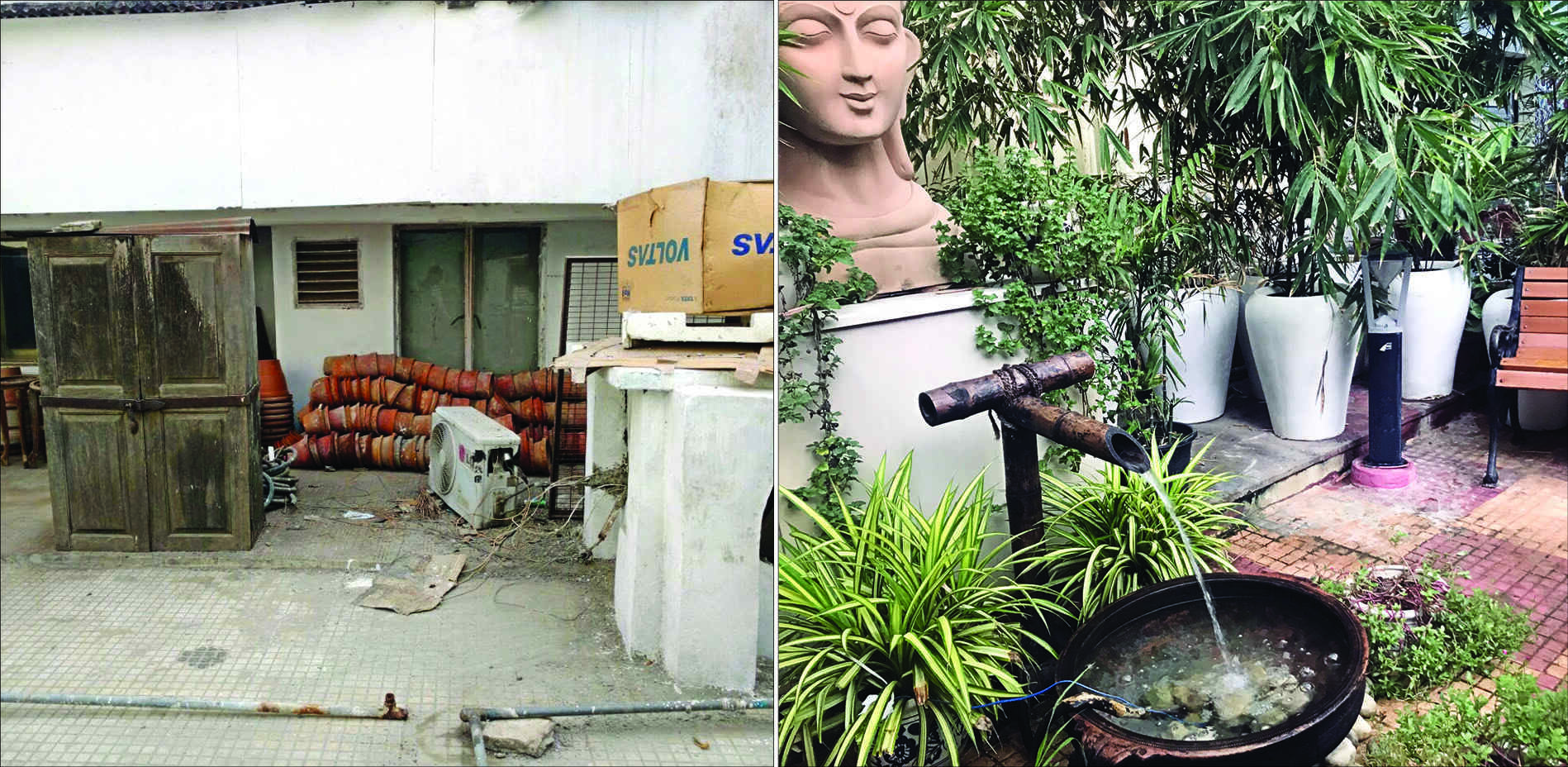Nexus of Good: From dump to courtyard
Dak Bhavan's Frangipani Aangan — created out of a dumping yard — bears testimony to the excellent grassroots-level efforts made by the Department of Post

"You can't use up creativity. The more you use, the more you have."
~Maya Angelou
It was December 26. The mobile phone of Smriti Sharan — a postal service officer — would not stop ringing, and congratulatory messages flooded her inbox. It took her a while to realise why this was happening. It so happened that the Prime Minister of India had hailed the transformation of a dump yard into a courtyard in her office space. It was indeed a proud day for the Department of Post (DoP).
It is difficult to believe but the green courtyard located on the second floor of Dak Bhavan was once a dump ground for garbage, broken coolers, pipes, redundant ACs, broken pots, discarded iron scaffoldings, monkey droppings, overflowing water from an AC chiller plant etc. When Smriti returned to the department from her deputation, she realised that nothing had changed in the past seven years, except that the garbage heap in the courtyard was higher, and the place stood neglected and frozen in time.
In 2017, the department accepted a proposal of Central Postal Ladies Organisation (CPLO) — a non-profit registered with DoP — to clean up the place and undertake essential civil and electrical works. IPPB (India Posts Payments Bank) stepped in to sponsor the beautification of the courtyard.
That set the ball rolling. CPLO commissioned artists, calligraphers and a plant stylist. They worked diligently to paint the walls with Warli art, write Sanskrit shlokas in beautiful calligraphy, put glass artwork over windows and create a garden with Champa, bamboo and seasonal flowering plants. The team worked for three months to bring to life what we now see as Frangipani Aangan.
Walls of the courtyard are adorned with Sanskrit shlokas that extol the virtue of keeping the Earth green by planting flowers and fruit-bearing trees. The glass art is a mix of murals and catchy Hindi words that signify the myriad moods found in nature, like dhwani, aviral, avinashwar, sangeet, suryoday, raag-rang etc.
The Champa trees are accompanied by Buddha-belly bamboo plants that give the aangan a zen garden feel. A beautiful sandstone Buddha statue was placed in one corner to create a zen space, and a fountain at the base of the statue was set to complete the zen experience. Benches were placed on either side for staff to sit by and take breaks during a hectic day.
Frangipani is a small, deciduous, low-branching garden tree with smooth pointed leaves tapering at both ends. Two common varieties found in Delhi are plumeria rubra and plumeria obtusa. Frangipani tree is commonly referred to as Champa, temple tree or pagoda tree. In Sanskrit, the trees are called Champak vriksh, and Champa flowers are used as votive offerings of worship. The flowers are strongly scented, present in loose upright clusters attached to a long common stalk. Colours of the flower range from pink to deep crimson to white with a golden centre.
Why name the aangan after the frangipani flower? While there are abundant winter flowers, during the peak summer months, when most flowers dry up, the frangipani blooms in all its splendour. Since frangipani trees are short and deciduous, they were considered perfect for the Aangan. Their short trunks made it easy to grow them in pots, and ensure dense foliage. The strong scent of the flower and splash of colour just adds to the frangipani magic. That's how the idea of Frangipani Aangan came up, and got realised.
So, what makes this dump-yard to courtyard journey so wonderful? Several aspects actually. Smriti made the courtyard design, and brought together an all-women team to do the artwork and plant greenery. The project was completed on a minimal budget. Everything about the courtyard was a thing of joy and pride.
It has been four years for the aangan, and today it is a place bustling with people. Frangicafe, run by CPLO, serves piping hot snacks, Maggi, bread-omelette, tea, coffee etc. Staff and officers use this facility alike. It is used for big and small festivities, including New Year, Holi, Diwali, Christmas and several birthdays and superannuation parties. The place had also served as a venue for Hindustani classical singing during Basant Panchami in 2019 and 2020. The courtyard is really a place where the postal fraternity makes bonds and shares small and big joys with each other.
When the Prime Minister hailed this effort of CPLO of converting a dump yard to a courtyard and cafeteria as a transformative journey, it brought immense cheer to the CPLO camp. As the PM had rightly said that for him, MannKiBaat was all about highlighting collective efforts of grassroots-level changemakers. That is what CPLO as a movement represents — changemakers at the grassroots level.
This dream became a reality on account of efforts made by IPPB (India Post Payments Bank) and its then CEO, AP Singh, who believed that the place could be transformed, and sponsored the creative endeavour. There was an enormous amount of support that came from several postal officers who stepped in to help complete the project despite several naysayers.
What Smriti accomplished is truly commendable and presents a wonderful example of Nexus of Good. The model is replicable. Many government offices have such 'dump-yards'. They can all be easily converted into spaces that are brighter, happier, ambient and inclusive — bringing pride for the organisation. It requires some imagination, commitment, meticulous planning and taking all the stakeholders on board. It can be done.
Views expressed are personal



